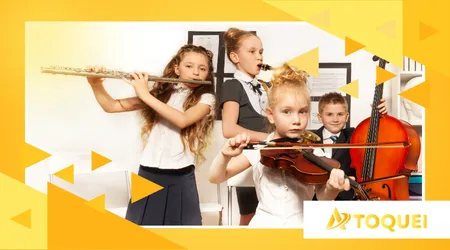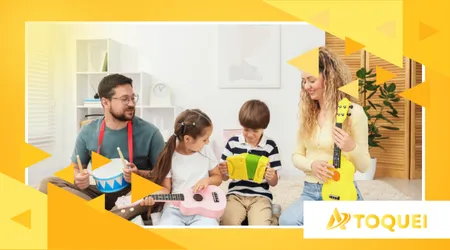Children's music vs. classical music: which works better in education?

Amidst playful songs and complex symphonies, the central question arises for parents and educators: Children's music vs. classical music, What is most effective in development?
Advertisements
This is a discussion that goes beyond mere preference.
The focus is on understanding how each genre contributes uniquely to the learning and holistic development of young children.
What does children's music offer to cognitive and social development?
Children's songs, with their simple melodies and repetitive lyrics, play a crucial role.
They facilitate memorization, improve language skills, and stimulate motor coordination through gestures and dances.
Advertisements
The participatory nature of these songs promotes socialization and a sense of community.
Rhythm and rhyme are powerful tools.
They help with pattern recognition. The inherent playfulness creates a lighthearted learning environment.
Children absorb basic concepts intuitively.
It is a vehicle for teaching values and daily routines.
Songs about hygiene or colors are clear examples.
++How to overcome the fear of public speaking.
The affection generated creates a strong emotional bond.
How Does Classical Music Impact Children's Brains?

Classical music, with its rich and complex harmonic structure, offers a more sophisticated form of brain training.
Exposure to the works of Bach or Mozart, for example, has shown potential to enhance logical-mathematical reasoning skills.
++How to set up a music corner for young children
The diverse instrumental music sharpens the listening skills. The concentration required improves focus.
The complexity of the pieces stimulates the formation of new neural connections.
Studies show a correlation with improved memory.
Appreciating a symphony teaches patience.
Introduces the concept of climax and resolution.
This cultural immersion broadens the child's horizons.
Explore also: How to Use Children's Songs to Work on Notes and Pitch
Instrumental music encourages the imagination.
Children's music vs. classical musicWhat are the integrated benefits of a mixed approach?

The question is not about choosing one over the other, but rather about integrating both musical universes.
The combination offers a full range of stimuli, catering to both playful needs and cognitive complexity.
Sonic diversity is fundamental to a rich musical education. The balance between simplicity and complexity is key.
See how interesting: USP project brings classical music closer to children.
Imagine the child singing "I threw the stick at the cat".
Next, she hears a passage from Vivaldi's "The Four Seasons".
This transition develops mental flexibility.
The brain works at different processing levels.
The child learns to appreciate melody in a comprehensive way.
This musical synergy enhances development.
The goal is to develop attentive and sensitive listeners.
Learning becomes deeper and more meaningful.
It's a more realistic approach to the art world.
Why are rhythm and structure essential in early childhood?
Rhythm is inherent to human development. From the beating of the heart, a child connects with cadence.
The structure of music, whether it be the simplicity of a children's song or the sonata form of classical music, offers order.
This sound organization is transferred to the organization of thought.
Rhythm facilitates language acquisition.
Pauses and accents are like punctuation in speech.
Music structures time in a non-verbal way.
The child learns to wait their turn, for example.
Melody acts as a conduit for emotion.
According to a 2019 study published in Journal of Research in Music Education, Continuous and diverse exposure to music, including classical music, in early childhood is positively correlated with higher scores on literacy tests and spatial skills.
This data highlights the importance of sound amplitude.
| Musical Genre | Main Educational Focus | Primary Skills Developed |
| Children's Music | Playful and Social | Language, Motor Coordination, Socialization |
| Classical Music | Cognitive and Auditory | Logical Reasoning, Concentration, Memory |
One example of a practical application is using the repetitive melody of a children's song. This repetition helps in memorizing multiplication tables.
Another example: after the singing, one could play Saint-Saëns' "Carnival of the Animals".
Children identify animals and their corresponding sounds. This enhances selective listening skills.
This technique transforms listening into an active process.
Music becomes a multidisciplinary tool.
Child development is viewed as a mosaic.
Each note, rhythm, or instrument adds a unique color.
After all, why limit the musical journey to just one path?
Children's music vs. classical music: Understanding the synergy.
Think of music education as building a house.
THE Children's music vs. classical music They represent the essential and complementary materials.
Children's songs are the basic bricks and mortar, providing the solid structure and fundamental foundation.
Classical music, on the other hand, is characterized by sophisticated finishing touches and complex architectural design.
It adds depth, aesthetic beauty, and challenges the engineering of the mind.
A house needs both to be functional, beautiful, and durable.
What matters is the quality of the listening experience.
One should always seek out repertoires of high value.
The exposure must be intentional and planned.
The joy of musical discovery should be encouraged.
THE Children's music vs. classical music It should be a celebration.
It is the art of sound in service of holistic development.
Conclusion: The Importance of Musical Diversity
Effective music education in childhood is not limited to duality. Children's music vs. classical music.
The most promising path is conscious integration.
Both genres offer undeniable benefits. Children who grow up exposed to this sonic richness develop more fully.
She gains valuable cognitive, emotional, and social tools for life.
The educator's role is to be the conductor of this orchestra of learning.
The future is built with diverse and harmonious notes.
Respect for art in all its forms is taught.
Music is a powerful agent of transformation.
It prepares the child for a more complex world.
Frequently Asked Questions
1. What is the ideal age to introduce classical music?
There is no minimum age. Even from the womb, the baby can be exposed. In early childhood, listening to short, cheerful excerpts is recommended. The important thing is that the exposure is enjoyable.
2. Does a child need to know how to play an instrument?
Playing an instrument is excellent, but it's not mandatory. Simply listening actively and participating in musical activities already brings great cognitive and emotional benefits. Formal learning can come later.
3. Can too much children's music be harmful?
Excessive stimulation of any kind can be limiting. The ideal is diversity. Excessive repetition of a single song or style can prevent a child from exploring other rhythms and harmonies, which are essential for complete development.
Would you like to learn more about specific techniques for introducing classical music to children in early childhood?
